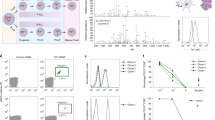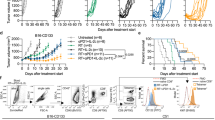Abstract
The genetic transfer of antigen receptors provides a means to rapidly generate autologous tumor-reactive T lymphocytes. However, recognition of tumor antigens by cytotoxic T cells is only one step towards effective cancer immunotherapy. Other crucial biological prerequisites must be fulfilled to expand tumor-reactive T cells that retain a functional phenotype, including in vivo cytolytic activity and the ability to travel to tumor sites without prematurely succumbing to apoptosis. We show that these requirements are met by expanding peripheral blood T cells genetically targeted to the CD19 antigen in the presence of CD80 and interleukin-15 (IL-15). T cells expanded in the presence of IL-15 uniquely persist in tumor-bearing severe combined immunodeficiency (SCID)-Beige mice and eradicate disseminated intramedullary tumors. Their anti-tumor activity is further enhanced by in vivo co-stimulation. In addition, transduced T cells from patients with chronic lymphocytic leukemia (CLL) effectively lyse autologous tumor cells. These findings strongly support the clinical feasibility of this therapeutic strategy.
This is a preview of subscription content, access via your institution
Access options
Subscribe to this journal
Receive 12 print issues and online access
$209.00 per year
only $17.42 per issue
Buy this article
- Purchase on SpringerLink
- Instant access to full article PDF
Prices may be subject to local taxes which are calculated during checkout





Similar content being viewed by others
Change history
10 February 2003
This was incorrect in AOP version but corrected in print. Added NIH grant AI44926 to acknowledgments as per note.
Notes
NOTE: In the version of this article initially published online, NIH grant AI44926 was omitted from the acknowledgments. This mistake has been corrected for the HTML and print versions of the article.
References
Collins, R.H. et al. Donor leukocyte infusions in 140 patients with relapsed malignancy after allogeneic bone marrow transplantation. J. Clin. Oncol. 15, 433–444 (1997).
Riddell, S.R., Murata, M., Bryant, S. & Warren, E.H. T-cell therapy of leukemia. Cancer Control 9, 114–122 (2002).
Papadopoulos, E.B. et al. Infusions of donor leukocytes to treat Epstein-Barr virus-associated lymphoproliferative disorders after allogeneic bone marrow transplantation. N. Engl. J. Med. 330, 1185–1191 (1994).
Savoldo, B., Heslop, H.E. & Rooney, C.M. The use of cytotoxic T cells for the prevention and treatment of Epstein-Barr virus induced lymphoma in transplant recipients. Leukemia Lymphoma 39, 455–464 (2000).
Melief, C.J. et al. Strategies for immunotherapy of cancer. Adv. Immunol. 75, 235–282 (2000).
Sadelain, M., Rivière, I. & Brentjens, R. Targeting tumors with genetically enhanced T lymphocytes. Nat. Rev. Cancer 3, 35–45 (2003).
Eshhar, Z. et al. The T-body approach: potential for cancer immunotherapy. Springer Semin. Immunopathol. 18, 199–209 (1996).
Schumacher, T.N. T-cell-receptor gene therapy. Nat. Rev. Immunol. 2, 512–519 (2002).
Uckun, F.M. et al. Detailed studies on expression and function of CD19 surface determinant by using B43 monoclonal antibody and the clinical potential of anti- CD19 immunotoxins. Blood 71, 13–29 (1988).
Gong, M.C. et al. Cancer patient T cells genetically targeted to prostate-specific membrane antigen specifically lyse prostate cancer cells and release cytokines in response to prostate-specific membrane antigen. Neoplasia 1, 123–127 (1999).
Latouche, J.B. & Sadelain, M. Induction of human cytotoxic T lymphocytes by artificial antigen-presenting cells. Nat. Biotechnol. 18, 405–409 (2000).
Maher, J., Brentjens, R.J., Gunset, G., Riviere, I. & Sadelain, M. Human T-lymphocyte cytotoxicity and proliferation directed by a single chimeric TCR-ζ/CD28 receptor. Nat. Biotechnol. 20, 70–75 (2002).
Rosenberg, S.A. Progress in human tumour immunology and immunotherapy. Nature 411, 380–384 (2001).
Rossi, E. et al. ζ chain and CD28 are poorly expressed on T lymphocytes from chronic lymphocytic leukemia. Leukemia 10, 494–497 (1996).
Chen, X. et al. Impaired expression of the CD3-ζ chain in peripheral blood T cells of patients with chronic myeloid leukaemia results in an increased susceptibility to apoptosis. Br. J. Haematol. 111, 817–825 (2000).
Hanson, H.L. et al. Eradication of established tumors by CD8+ T cell adoptive immunotherapy. Immunity 13, 265–276 (2000).
Ochsenbein, A.F. et al. Roles of tumour localization, second signals and cross priming in cytotoxic T-cell induction. Nature 411, 1058–1064 (2001).
Sadelain, M. & Rivière, I. Sturm und Drang over suicidal lymphocytes. Mol. Ther. 5, 655–657 (2002).
Dudley, M.E. et al. A phase I study of nonmyeloablative chemotherapy and adoptive transfer of autologous tumor antigen-specific T lymphocytes in patients with metastatic melanoma. J. Immunother. 25, 243–251 (2002).
Boussiotis, V.A., Lee, B.J., Freeman, G.J., Gribben, J.G. & Nadler, L.M. Induction of T cell clonal anergy results in resistance, whereas CD28-mediated costimulation primes for susceptibility to Fas- and Bax-mediated programmed cell death. J. Immunol. 159, 3156–3167 (1997).
Vella, A.T. et al. CD28 engagement and proinflammatory cytokines contribute to T cell expansion and long-term survival in vivo. J. Immunol. 158, 4714–4720 (1997).
Brocker, T. Chimeric Fv-ζ or Fv-ε receptors are not sufficient to induce activation or cytokine production in peripheral T cells. Blood 96, 1999–2001 (2000).
Fehniger, T.A., Cooper, M.A. & Caligiuri, M.A. Interleukin-2 and interleukin-15: immunotherapy for cancer. Cytokine Growth Factor Rev. 13, 169–183 (2002).
Waldmann, T.A., Dubois, S. & Tagaya, Y. Contrasting roles of IL-2 and IL-15 in the life and death of lymphocytes: implications for immunotherapy. Immunity 14, 105–110 (2001).
Bulfone-Paus, S. et al. Interleukin-15 protects from lethal apoptosis in vivo. Nat. Med. 3, 1124–1128 (1997).
Marks-Konczalik, J. et al. IL-2-induced activation-induced cell death is inhibited in IL-15 transgenic mice. Proc. Natl. Acad. Sci. USA 97, 11445–11450 (2000).
Li, X.C. et al. IL-15 and IL-2: a matter of life and death for T cells in vivo. Nat. Med. 7, 114–118 (2001).
Zhang, X., Sun, S., Hwang, I., Tough, D.F. & Sprent, J. Potent and selective stimulation of memory-phenotype CD8+ T cells in vivo by IL-15. Immunity 8, 591–599 (1998).
Ku, C.C., Murakami, M., Sakamoto, A., Kappler, J. & Marrack, P. Control of homeostasis of CD8+ memory T cells by opposing cytokines. Science 288, 675–678 (2000).
Oppenheimer-Marks, N., Brezinschek, R.I., Mohamadzadeh, M., Vita, R. & Lipsky, P.E. Interleukin 15 is produced by endothelial cells and increases the transendothelial migration of T cells in vitro and in the SCID mouse-human rheumatoid arthritis model in vivo. J. Clin. Invest. 101, 1261–1272 (1998).
Jourdan, P. et al. Cytokines and cell surface molecules independently induce CXCR4 expression on CD4+ CCR7+ human memory T cells. J. Immunol. 165, 716–724 (2000).
Peled, A. et al. Dependence of human stem cell engraftment and repopulation of NOD/SCID mice on CXCR4. Science 283, 845–848 (1999).
Burger, J.A., Burger, M. & Kipps, T.J. Chronic lymphocytic leukemia B cells express functional CXCR4 chemokine receptors that mediate spontaneous migration beneath bone marrow stromal cells. Blood 94, 3658–3667 (1999).
Blazar, B.R. et al. CD28/B7 interactions are required for sustaining the graft-versus-leukemia effect of delayed post-bone marrow transplantation splenocyte infusion in murine recipients of myeloid or lymphoid leukemia cells. J. Immunol. 159, 3460–3473 (1997).
Maric, M., Zheng, P., Sarma, S., Guo, Y. & Liu, Y. Maturation of cytotoxic T lymphocytes against a B7-transfected nonmetastatic tumor: a critical role for costimulation by B7 on both tumor and host antigen-presenting cells. Cancer Res. 58, 3376–3384 (1998).
Krause, A. et al. Antigen-dependent CD28 signaling selectively enhances survival and proliferation in genetically modified activated human primary T lymphocytes. J. Exp. Med. 188, 619–626 (1998).
Geiger, T.L., Nguyen, P., Leitenberg, D. & Flavell, R.A. Integrated src kinase and costimulatory activity enhances signal transduction through single-chain chimeric receptors in T lymphocytes. Blood 98, 2364–2371 (2001).
Hombach, A. et al. Tumor-specific T cell activation by recombinant immunoreceptors: CD3-ζ signaling and CD28 costimulation are simultaneously required for efficient IL-2 secretion and can be integrated into one combined CD28/CD3-ζ signaling receptor molecule. J. Immunol. 167, 6123–6131 (2001).
Haynes, N.M. et al. Single-chain antigen recognition receptors that co-stimulate potent rejection of established experimental tumors. Blood 100, 3155–3163 (2002).
Greenlee, R.T., Hill-Harmon, M.B., Murray, T. & Thun, M. Cancer Statistics, 2001. CA Cancer J. Clin. 51, 15–36 (2001).
Byrd, J.C. et al. Rituximab using a thrice weekly dosing schedule in B-cell chronic lymphocytic leukemia and small lymphocytic lymphoma demonstrates clinical activity and acceptable toxicity. J. Clin. Oncol. 19, 2153–2164 (2001).
Gallardo, H.F., Tan, C. & Sadelain, M. The internal ribosomal entry site of the encephalomyocarditis virus enables reliable coexpression of two transgenes in human primary T lymphocytes. Gene Ther. 4, 1115–1119 (1997).
Rivière, I., Brose, K. & Mulligan, R.C. Effects of retroviral vector design on expression of human adenosine deaminase in murine bone marrow transplant recipients engrafted with genetically modified cells. Proc. Natl. Acad. Sci. USA 92, 6733–6737 (1995).
Tedder, T.F. & Isaacs, C.M. Isolation of cDNAs encoding the CD19 antigen of human and mouse B lymphocytes. A new member of the immunoglobulin superfamily. J. Immunol. 143, 712–717 (1989).
Adonai, N. et al. Ex vivo cell labeling with 64Cu-pyruvaldehyde-bis(N4-methylthiosemicarbazone) for imaging cell trafficking in mice with positron-emission tomography. Proc. Natl. Acad. Sci. USA 99, 3030–3035 (2002).
Acknowledgements
This work was supported by US National Institutes of Health grants CA-59350, CA-86438, CA-08748, CA-83084 and AI44926; the Translational and Integrative Medicine Research Fund at the Memorial Sloan-Kettering Cancer Center; the Lymphoma Research Foundation (formerly the Cure for Lymphoma Foundation; fellowship award to R.J.B.); the Goodwin ETC fund; Golfers Against Cancer; and US Department of Energy grant ER-62039.*Footnote 1
Author information
Authors and Affiliations
Corresponding author
Ethics declarations
Competing interests
The authors declare no competing financial interests.
Rights and permissions
About this article
Cite this article
Brentjens, R., Latouche, JB., Santos, E. et al. Eradication of systemic B-cell tumors by genetically targeted human T lymphocytes co-stimulated by CD80 and interleukin-15. Nat Med 9, 279–286 (2003). https://doi.org/10.1038/nm827
Received:
Accepted:
Published:
Issue Date:
DOI: https://doi.org/10.1038/nm827
This article is cited by
-
IL-10-expressing CAR T cells resist dysfunction and mediate durable clearance of solid tumors and metastases
Nature Biotechnology (2024)
-
Challenges and new technologies in adoptive cell therapy
Journal of Hematology & Oncology (2023)
-
Life-changing cystic fibrosis treatment wins US$3-million Breakthrough Prize
Nature (2023)
-
Remote control of cellular immunotherapy
Nature Reviews Bioengineering (2023)
-
TET2 guards against unchecked BATF3-induced CAR T cell expansion
Nature (2023)



